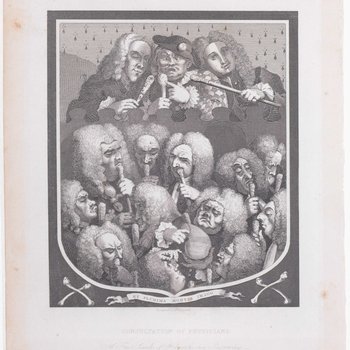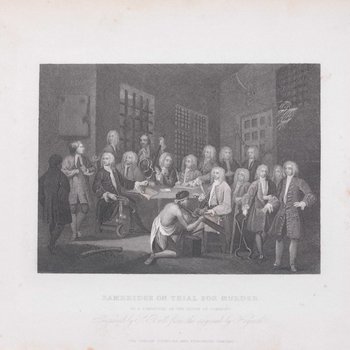Satirical Prints by Hogarth
A series of facsimile 18th century prints by William Hogarth caricaturing the fields of law, medicine, and education.
The Bench
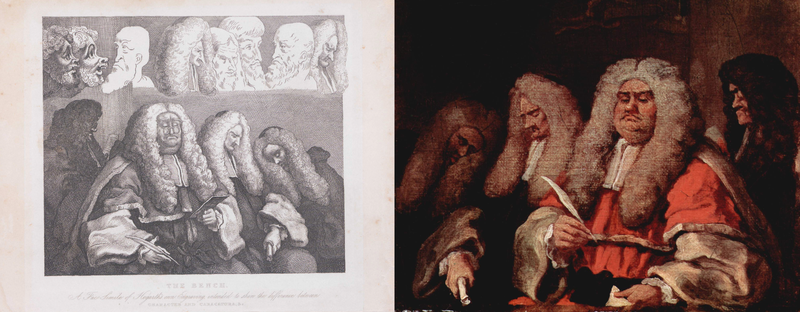
Original painting completed by Hogarth in 1754, housed at the Fitzwilliam Museum at the University of Cambridge
Facsimile print by the London Printing and Publishing Company.
Published with the subtitle “A facsimile of Hogarth’s own engraving intended to show the difference between CHARACTER and CARACATURA,” this print juxtaposes the images of prominent English judges with exaggerated caricatures in the upper portion. This caricature section, referred to as “the second state” in discourse on the print, is rendered in less detail as it was incomplete when Hogarth died in 1764.
In the 1833 book The Works of William Hogarth: In a Series of Engravings author John Trussler identifies the four seated figures and describes their various states of inattention:
The four sages on the Bench, are intended for Lord Chief Justice Sir John Willes, the principal figure; on his right hand. Sir Edward Clive; and on his left, Mr. Justice Bathurst, and the Hon. William Noel.
One is amusing himself, in the course of trial, with other business; another, in all the pride of self-importance, is examining a former deposition, wholly inattentive to that before him; the next is busied in thoughts quite foreign to the subject; and the senses of the last are locked fast in sleep.
The Charatcer/Caracatura technique used by Hogarth in “The Bench” as described by the artist in Anecdotes of William Hogarth, Written by Himself:
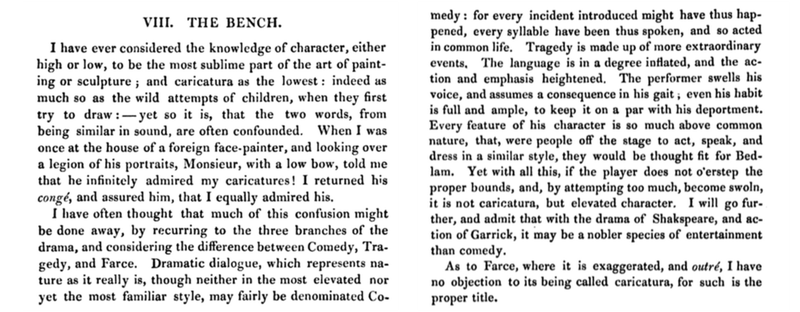
Hogarth also used this technique of juxtaposition in the popular 1743 engraving “Characters and Caricaturas” held at the Metropolitan Museum of Art in New York City.

Scholars at a Lecture, 1736
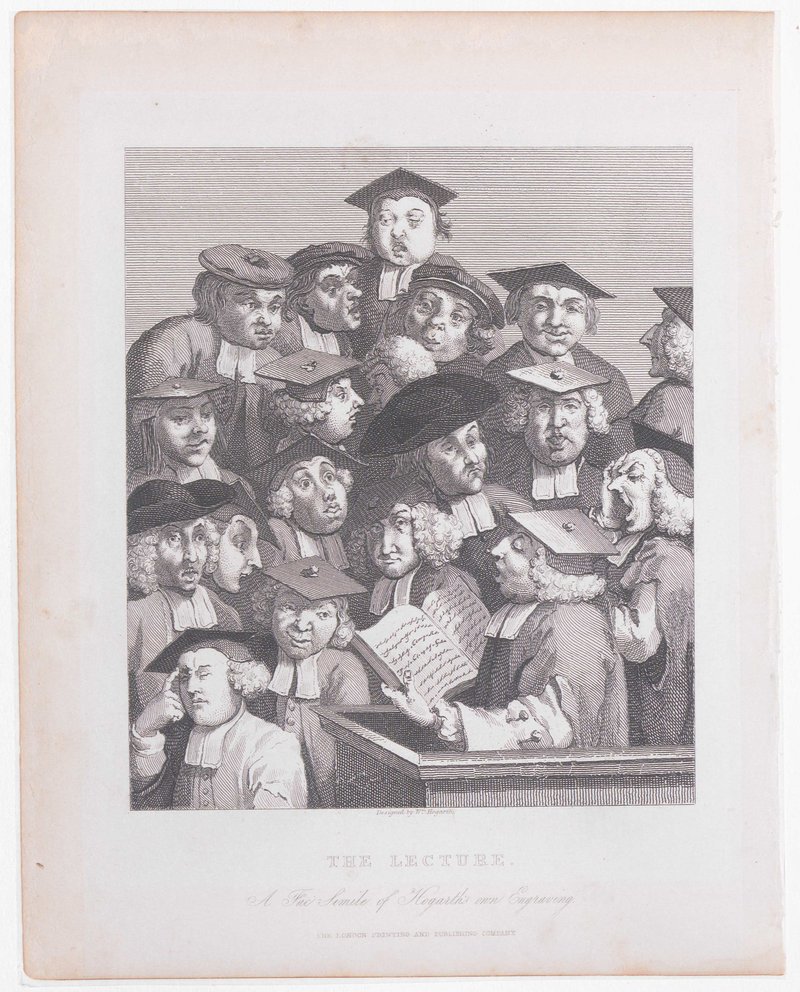
William Hogarth, etching and engraving
Facsimile print by the London Printing and Publishing Company
Described by the British Museum as “Scholars at a lecture; Oxford, portrayed as an assemblage of heads wearing square-topped, round cloth and felt hats and expressing varieties of boredom, listening to a reader in a lectern at lower right, his book inscribed in ink, with various squiggles, 'Datur Vacuum'.” The central figure at the lectern is identified as William Fisher (died 1761), Registrar of Oxford University.
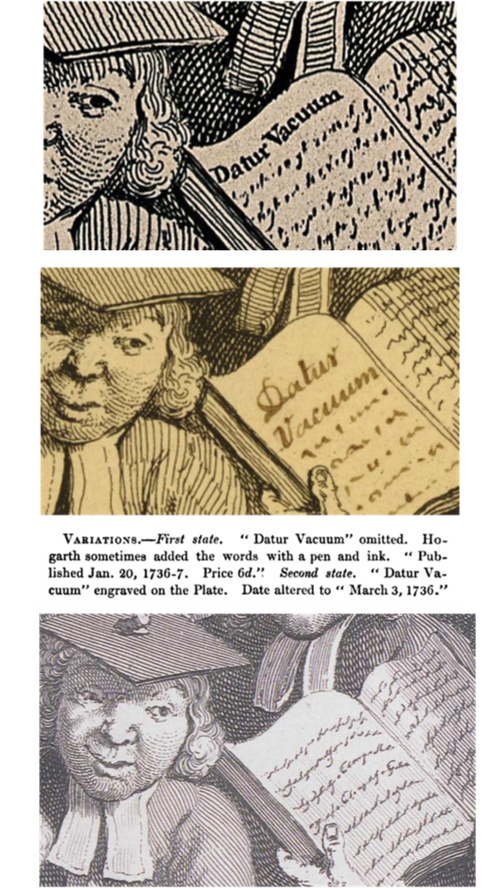
The Latin phrase Datur Vacuum (literally “a void is given”) is translated here by curators at the British Museum as “Leisure time is given for...” reflecting the comical disinterest of the gathered scholars.
In the National Portrait Gallery London print, Datur Vacuum is clearly printed as part of the intaglio process:
In the version held at the British Museum version, Datur Vacuum is handwritten in heavy looping script:
These variations are indexed in the 1833 publication Anecdotes of William Hogarth:
The print housed at the Barco Law Library does not feature the phrase Datur Vacuum at all. Also, the nonsense text in Fisher’s book is significantly different than the original print, suggesting a reproduction:
The company of undertakers, 1763
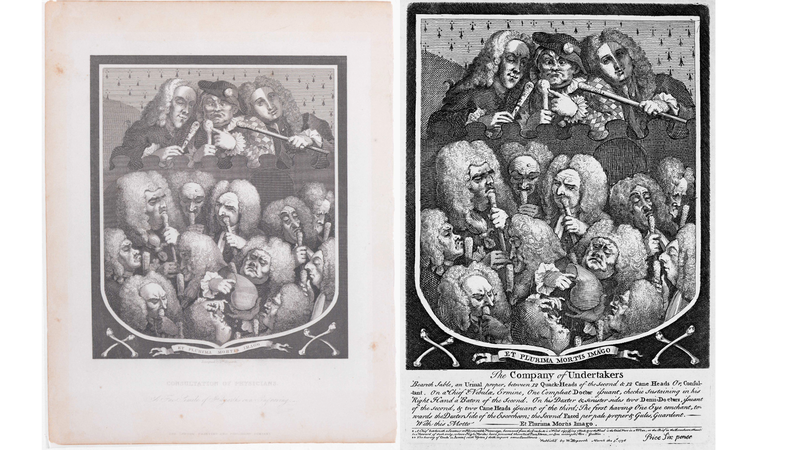
William Hogarth, etching and engraving
Facsimile print by the London Printing and Publishing Company
A 1763 print showing a group of undertakers arranged in a satirical coat of arms, this image incorporates many elements common to European heraldry. These include the background escutcheon (shield), lower motto (Et plurima mortis imago or And everywhere the image of death/ And many are the faces of death), an ermine charge (a traditional heraldic pattern or tincture denoting royalty running horizontally across the top), and the original version of this print included a lyrical blazon (stylized description of the figures and elements for reproduction) using the proper French heraldic lexicon for satirical effect.
The upper portion of the Coat of Arms shows three identifiable figures, John Taylor, Sarah Mapp, and Joshua Ward, all well known for fraudulent and dangerous medical practices in 18th century England.
Blazon, from the lower section of the original print:
Beareth sable, a urinal, proper, between twelve quack-heads of the second, and twelve cane-heads, or consultant. On a chief, nebulae, ermine, one complete doctor, issuant, checkie, sustaining, in his right hand, a baton of the second. On his dexter and sinister sides two demi-doctors, issuant, of the second, and two cane-heads, issuant of the third; the first having one eye, couchant, towards the dexter side of the escutcheon; the second, faced, per pale, proper, and gules guardant. With this motto—Et plurima mortis imago.
Bambridge on Trial for Murder by a Committee of the House of Commons, 1803
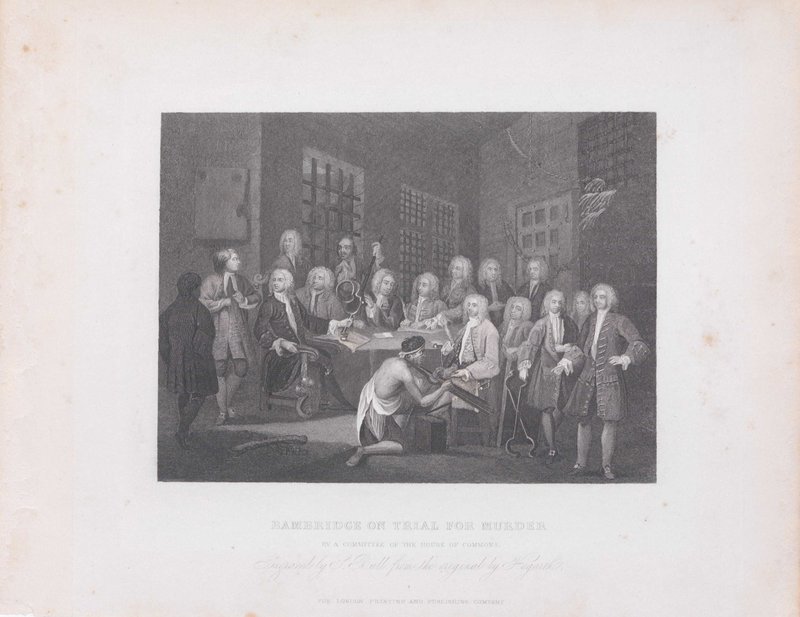
Thomas Cook, approximately 1744-1818, engraver
William Hogarth, 1697-1764, artist
Facsimile print by the London Printing and Publishing Company
With no obviously satirical elements, this 1803 print “shows several members of the House of Commons, including James Oglethorpe and Archibald Grant, gathered in a room at the Fleet Prison for an investigation of Thomas Bambridge, warden of the prison, for the brutal treatment of prisoners, one of whom is shown at center wearing a punishment device, known as the collar, that fits around the neck and one or both hands, another device, known as the sheers, is held by Grant, and another device, known as the skull cap, is held by Oglethorpe and two other committee members. Bambridge was subsequently tried at the Old Bailey for the murder of a prisoner.”
– Description by the Library of Congress.
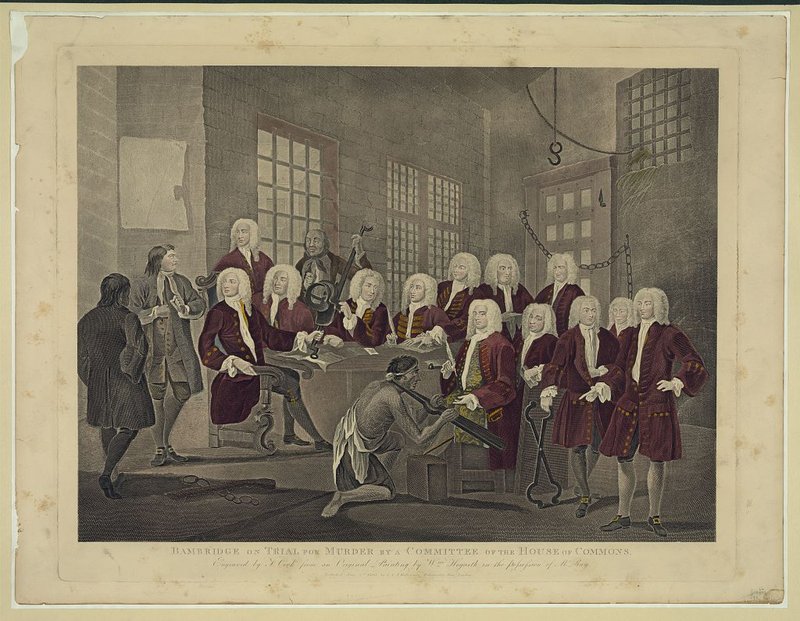
The original print was highly detailed and included colored elements added by screen printing or hand coloring.
References
The Fitzwilliam Museum, "The Bench" https://data.fitzmuseum.cam.ac.uk/id/object/3381
Gwyn, N.B. (1940). An interpretation of the Hogarth print "The Arms of the Company of Undertakers.” Bulletin of the History of Medicine. 8 (1): 115–27: https://archive.org/details/sim_bulletin-of-the-history-of-medicine_1940-01_8_1/page/n123/mode/2up
Hogarth, William (1833). "Remarks on various prints". Anecdotes of William Hogarth, Written by Himself: With Essays on His Life and Genius, and Criticisms on his Work. J.B. Nichols and Son.
Hogarth, William (1833). "Remarks on various prints". Anecdotes of William Hogarth, Written by Himself: With Essays on His Life and Genius, and Criticisms on his Work. J.B. Nichols and Son, p. 198.
Library of Congress, Bambridge on trial for murder by a committee of the House of Commons / engraved by T. Cook from an original painting by Wm. Hogarth in the possession of Mr. Ray, https://www.loc.gov/item/2012647274/
The Metropolitan Museum of Art, Bambridge on Trial for Murder by a Committee of the House of Commons, https://www.metmuseum.org/art/collection/search/406317
Trusler, John (1833). The Works of William Hogarth. London: Jones and Co.
Images
British Museum, Scholars at a Lecture, https://www.britishmuseum.org/collection/object/P_1868-0822-1545
Metropolitan Museum of Art, Characters and Caricaturas, April 1743, https://www.metmuseum.org/art/collection/search/392594
National Portrait Gallery London, Scholars at a Lecture, https://www.npg.org.uk/collections/search/portrait/mw113132/Scholars-at-a-Lecture
Wikimedia, William Hogarth, The Bench (Oil Painting), held by the Fitzwilliam Museum, https://commons.wikimedia.org/wiki/File:William_Hogarth_004.jpg



